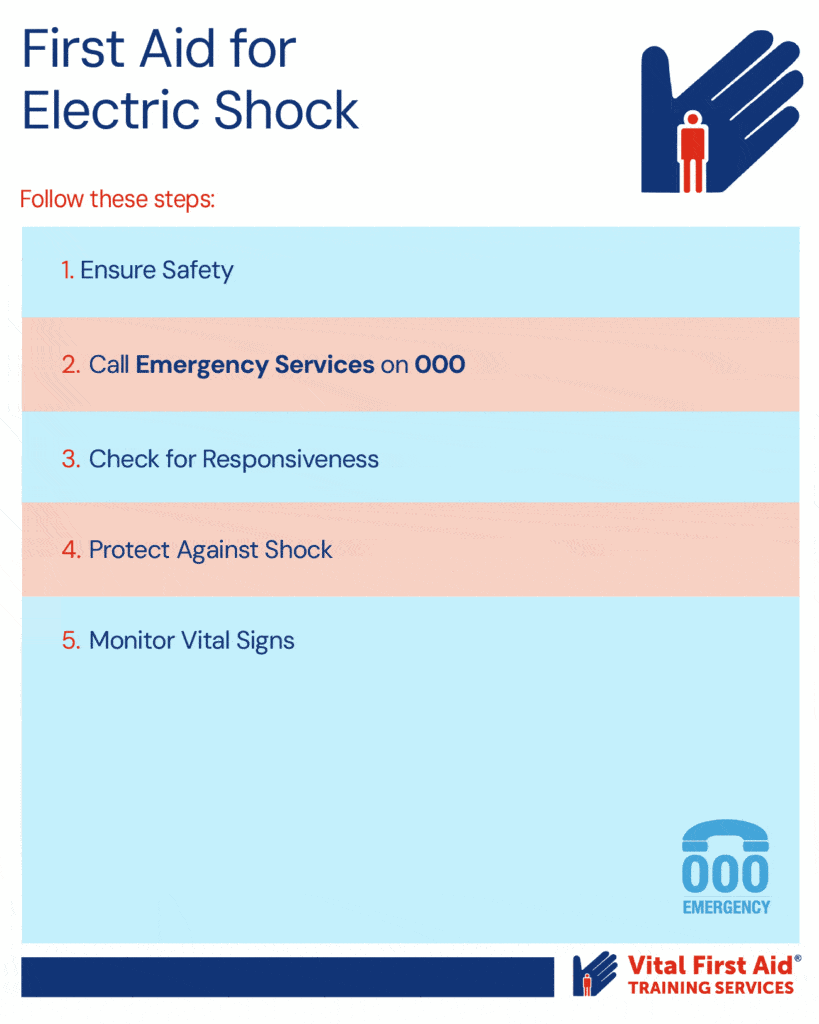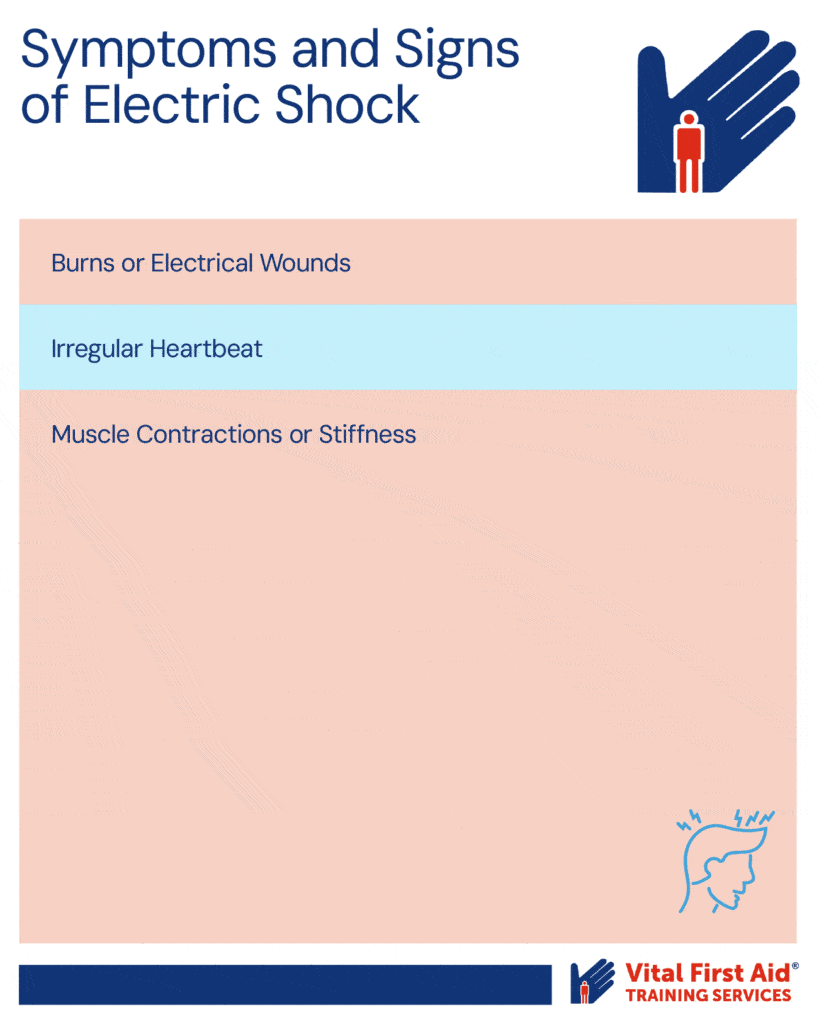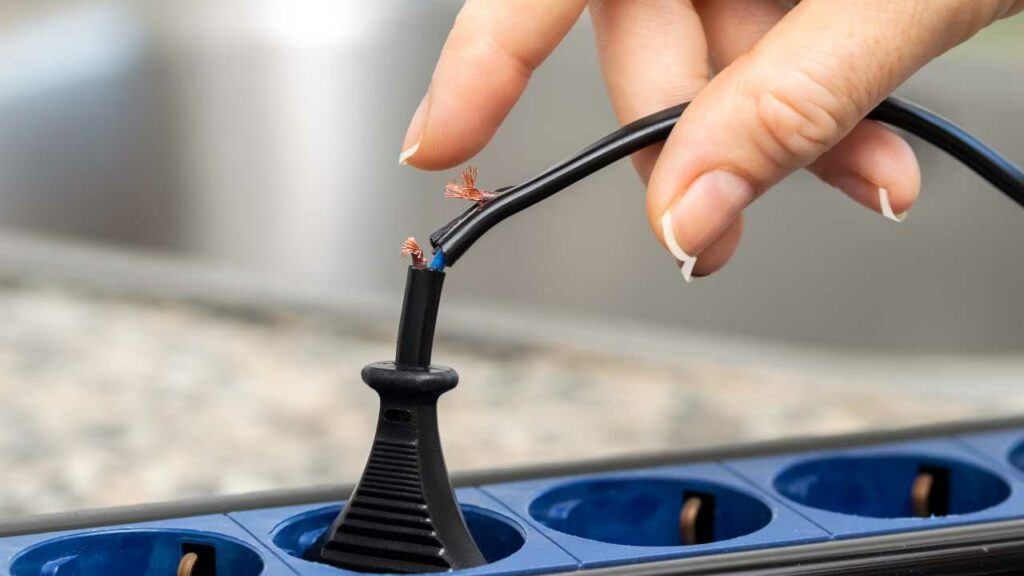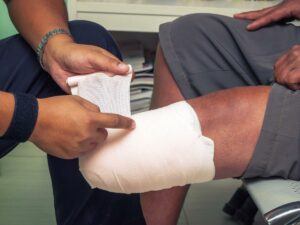The Vital Facts
- According to a study conducted from 2014 to 2015:
- 90% of electrical deaths associated with electricity networks involve overhead conductors.
- Consumer appliances caused twice as many deaths (285) as electrical supplier assets (144).
- Age-specific hospitalisation rates for electrical injuries were highest among young men aged 15–24.
- Work-related incidents accounted for 47% of electrical injury hospitalisations.
Electric shock injuries can occur unexpectedly and pose serious risks to a victim’s health and vital internal functions.
Whether you regularly work with electrical equipment or simply encounter hazardous situations at home or out and about, understanding how to prevent and respond to electric shocks is important.
For immediate first aid response to electric shocks, follow these steps:
- Ensure safety
- Call for emergency assistance
- Check for responsiveness
- Protect against shock
- Monitor vital signs
See here for a more in-depth explanation of the first aid steps for electric shock.
As you read on, we will explore what electric shock injuries are, how to avoid them, how to recognise their symptoms and provide essential first aid for electric shock when an incident occurs.

Jump to a section in this blog:
- What is an electric shock injury?
- How to prevent an electric shock injury
- Signs and symptoms of an electric shock injury
- First aid for electric shock
What is An Electric Shock Injury?
An electric shock injury refers to the physical harm caused by an electric current passing through the body.
This can take place due to direct contact with electrical sources or even indirectly through contact with conductive materials or surfaces that have become electrified such as water or metal objects.
The severity of the electric shock injury depends on factors such as the voltage, current intensity, duration of exposure, and the pathway the current takes through the body.
How to Prevent Electric Shock Injuries
1. Awareness and Education
The best way to prevent electric shock injuries is to educate yourself and others about electrical safety – knowledge is the first line of defence! It’s important to understand the risks associated with electrical equipment, power lines, and outlets.
2. Electrical Equipment Inspection
Next, you must regularly inspect electrical appliances, cords, and outlets for any signs of damage, such as frayed wires or exposed conductors. These are a common cause of injury and so you’ll need to replace or repair faulty equipment immediately.
3. Ground Fault Circuit Interrupters (GFCIs)
Another handy tip is to install GFCIs in areas where water and electricity are in close proximity, such as kitchens, bathrooms, and outdoor spaces. GFCIs quickly interrupt the power supply when they detect a ground fault to dramatically reduce the risk of an electric shock.
4. Electrical Outlet Safety
Finally, avoid overloading outlets with multiple plugs or extension cords – this only increases the chances of a problem or damage. Alternatively, ensure that outlets are properly covered and even use childproof caps if necessary.
Symptoms and Signs of Electric Shock Injuries
A key step in first aid for an electric shock is first recognising the signs of an electric shock injury so your response is both timely and effective. The following symptoms may indicate an electric shock:
1. Burns or Electrical Wounds
It’s important to look for any burns at the point of contact with the electrical source. These may appear as blisters or charred skin on the surface. However, they can also be internal, so it’s important to err on the side of caution.
2. Irregular Heartbeat
Electric shocks can disrupt the patient’s heart and its normal rhythm, leading to an irregular heartbeat or potentially even a cardiac arrest.
3. Muscle Contractions or Stiffness
Electric shocks can also cause involuntary muscle contractions, resulting in temporary paralysis or a “freezing” effect.

First Aid for Electric Shock
If you encounter someone who has suffered from an electric shock injury, it is crucial to take immediate action with these first aid steps:
1. Ensure Safety
The first rule of any first aid procedure is to prioritise your safety and then the victims. Disconnect the power source or any other hazards using a non-conductive object to separate the victim from the source, such as a dry wooden broom or rubber gloves.
2. Call for Emergency Assistance
Dial emergency services immediately or ask someone nearby to do so. Inform them about the details of the electric shock incident and provide your location.
3. Check for Responsiveness
Next, assess the victim’s consciousness and breathing. If they are unresponsive or not breathing, begin CPR immediately.
4. Protect Against Shock
After any significant injury, there is a risk of a person going into shock. This is not to be confused with being shocked. Shock is a bodily response to a traumatic injury, and can be life-threatening.
To prevent going into shock, if the victim is conscious and breathing, keep them lying down unless they are short of breath. If they are conscious but having breathing difficulties, you may need to sit them up partially. It also helps to cover them with a blanket to maintain their body temperature.
5. Monitor Vital Signs
While you wait for emergency services, observe the victim’s vital signs, such as breathing and pulse rate. Be prepared to administer CPR if necessary until medical help arrives.
Complete a First Aid Course
Why complete a first aid course? Because you’ll immediately feel more comfortable and confident!
Whether you are an individual working with electricity or simply want to ensure the safety of you and your family in the home, it’s important that you have the knowledge and skills to confidently administer first aid and respond to a medical emergency until professional medical assistance is available.
At Vital First Aid, our qualified first aid trainers are highly skilled and experienced, and all first aid students will receive a First Aid Certificate on completion.
To benefit from our range of first aid courses, sign up here.






